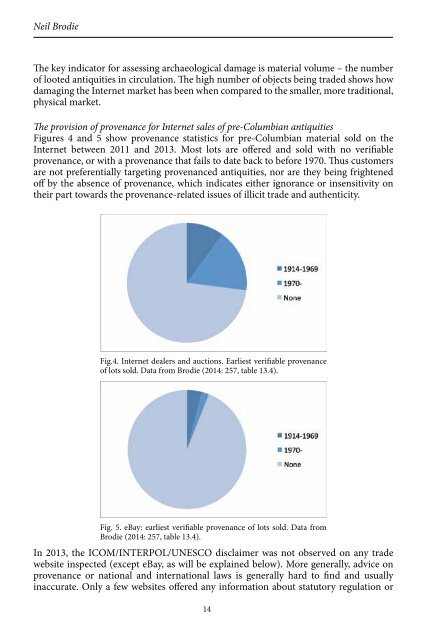Countering
Book_observatory_illicit_traffic_version%20issuu
Book_observatory_illicit_traffic_version%20issuu
Create successful ePaper yourself
Turn your PDF publications into a flip-book with our unique Google optimized e-Paper software.
The Internet Market in Antiquities<br />
the importance of establishing a documented provenance. When advice was offered<br />
it was most commonly to assert the importance of the 1970 date of the UNESCO<br />
Convention on the Means of Prohibiting and Preventing the Illicit Import, Export and<br />
Transfer of Ownership of Cultural Property as a ‘bright line’, suggesting that material out<br />
of its country of origin before 1970 is legally on the market. This statement is incorrect.<br />
The legality or otherwise of export is determined by national legislation, not the 1970<br />
UNESCO Convention. Where websites did provide information about appropriate<br />
laws and regulations it looked to be for cosmetic purposes only. On websites stating the<br />
importance of 1970 as a threshold date, for example, the majority of lots offered and sold<br />
had no dated provenance and thus nothing to guide a customer in search of pre-1970<br />
material.<br />
Most websites did offer ‘certificates of authenticity’, seemingly guaranteeing the<br />
authenticity of objects sold and offering the customer some protection against fraud. In<br />
reality, these certificates are badly misleading. They offer a money refund if a purchased<br />
antiquity is shown to be fake. As this would entail the customer paying for expert opinion<br />
or scientific analysis, a simple refund of purchase price would still leave the customer out<br />
of pocket. There is no incentive for a customer to pay for the necessary examination, and<br />
therefore little legal or financial risk to a merchant knowingly or unknowingly selling<br />
fakes.<br />
The CCPIA and the Internet market in pre-Columbian antiquities<br />
In 1983, the U.S.A enacted the Convention on Cultural Property Implementation Act<br />
(CCPIA) in implementation of the 1970 UNESCO Convention. Under the CCPIA, States<br />
whose cultural heritage is in imminent danger of looting and illicit trade can ask for a<br />
bilateral agreement obliging the U.S.A to place import controls on designated categories<br />
of cultural material from the country concerned. The agreements are formalized by<br />
means of a Memorandum of Understanding (MOU) and run for five years. They are<br />
open to renewal.<br />
Fig. 6. Proportions of total lots sold from countries without and<br />
without MOUs reached under the 1983 CPIA. Data from Brodie<br />
(2014: 259, table 13.8).<br />
Many of the Latin American countries that are the source of pre-Columbian antiquities<br />
have agreed MOUs with the U.S.A. Thus the import of pre-Columbian antiquities from<br />
any country with an MOU would be in violation of US law. There is no real evidence,<br />
15


